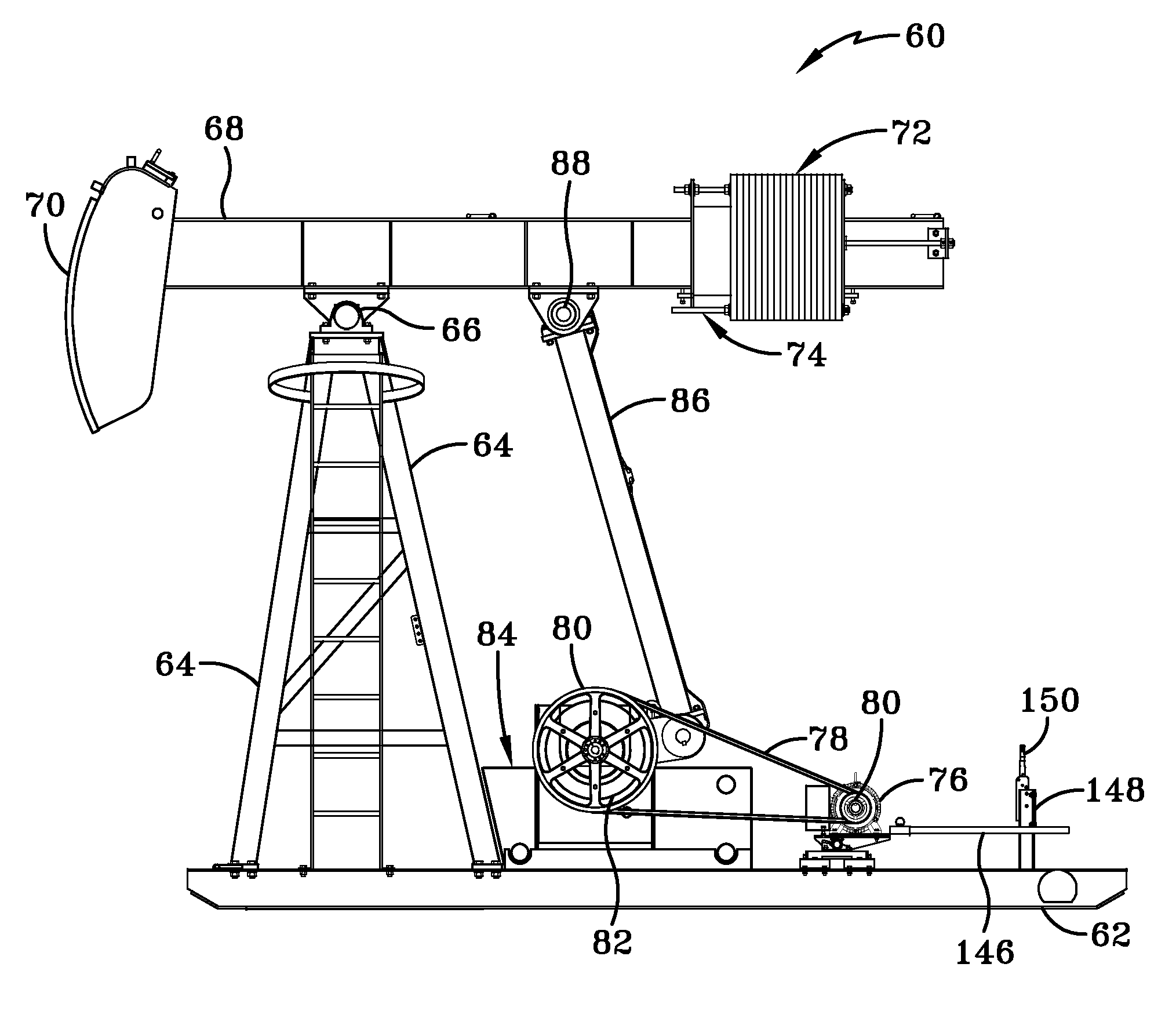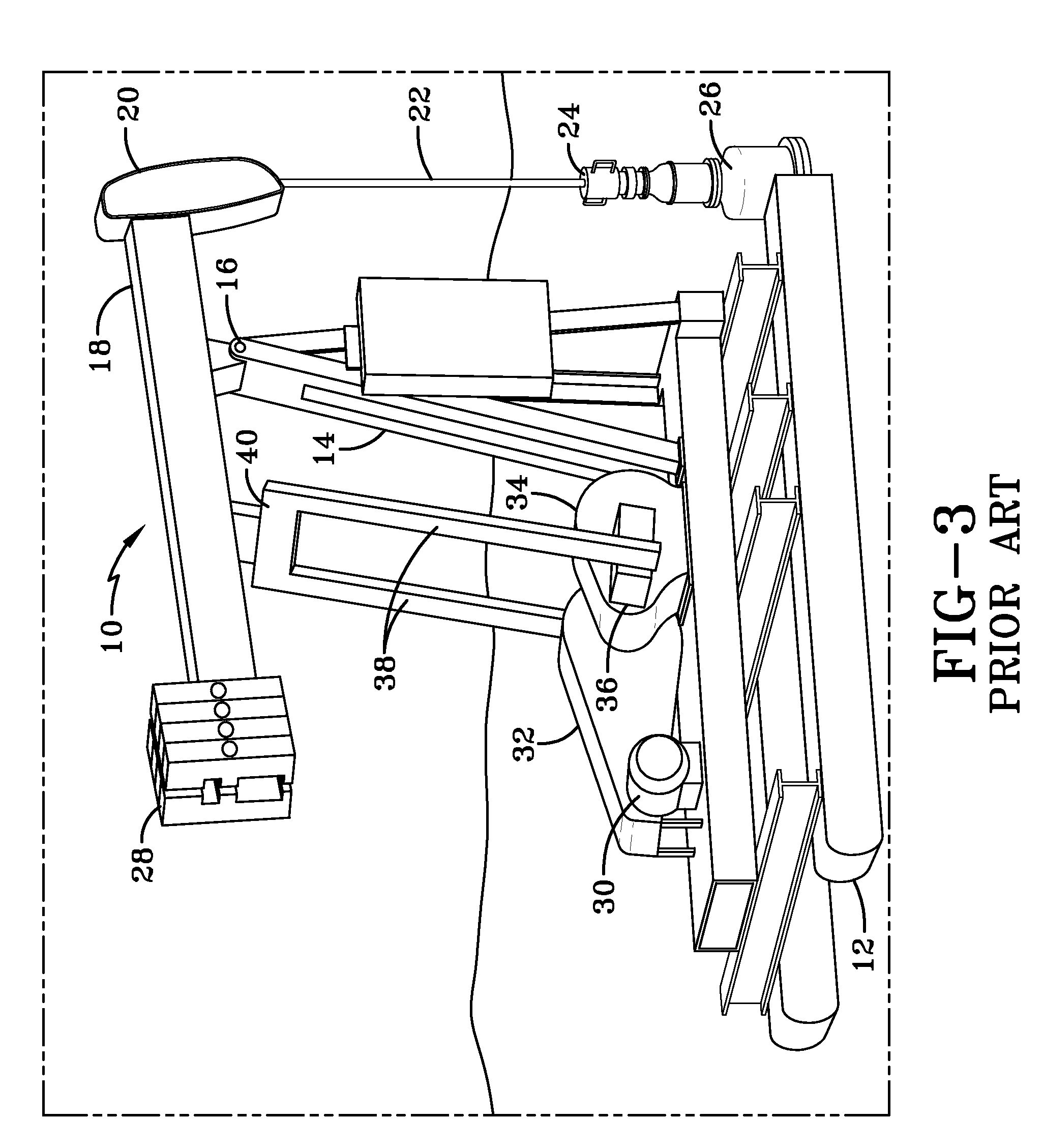All of these components are very heavy and require the use of a lifting device or crane to remove.
However, because the walking beam and beam weights are directly above the gear reducer, it is difficult to hoist the gear reducer up due to interference between the hoist mechanism and the walking beam.
In either case, the
mechanics find themselves in a position that may be dangerous due to its location directly under the heavy walking beam and beam weights.
The
mechanics must use care to ensure that the chains and / or binders securing the walking beam in place are not accidentally or inadvertently released, since the beam and weights might undesirably swing down toward the gear reducer.
Other disadvantages of prior art pumping units are associated with the type of gear reducer that has been used in the prior art.
More particularly, the prior art gear reducer is an expensive, custom-built parallel gearbox that is mounted on the base of the pumping unit.
Such a construction makes the gearbox very expensive.
The custom-built parallel gearbox of the prior art is also undesirably
time consuming and expensive to repair.
More particularly, when the gearbox is repaired in the field, multiple trips by
mechanics typically are required.
The parts for the repair of the custom gearbox typically can only be purchased from the original manufacturer, and may have to be specially made, which results in significant down time for the pumping unit.
This process is undesirably long and expensive, and during the long down time of the pumping unit no oil and / or gas is produced by the well, resulting in additional lost revenue for the well owner.
Such a high
stroke speed may be advantageous to pump a large amount of fluid, but may undesirably increase the amount of stress on the string of rods in the well and the amount of stress on the pumping unit itself.
In addition, if the foundation under the base of the pumping unit becomes out-of-level, a high
stroke speed of about 10 spm may cause the pumping unit to rock back and forth, which may damage the pumping unit.
Moreover, a
stroke speed of 10 spm requires more
horsepower (hp) and torque than a lower stroke speed, which is undesirable for both electric motors and internal
combustion engines.
Thus, in some cases, the distance between the main electric line and the motor is large enough that there is not enough amperage available to enable the motor to generate adequate
horsepower to run such a high-stroke-speed pumping unit.
At a higher rpm, the
internal combustion engine may experience operating problems, which may undesirably cause the engine to stall.
The parallel-gearbox type of gear reducers of the prior art also undesirably have limited torque ratings or torque capability.
Such increased force requirements in turn increase the amount of torque that is placed on the gear reducer.
This increased torque sometimes exceeds the
maximum torque ratings of the prior art parallel gearboxes, which may undesirably damage the gearbox.
Another
disadvantage of prior art pumping units is the use of different styles of bearing components, such as pins, bushings, and bearings throughout the pumping unit.
Thus, it becomes expensive for an
end user to keep an inventory of such components, and without such an inventory, the
end user may often have wait for up to six weeks for needed components to be made and shipped.
In addition, if the manufacturer goes out of business, it may not be possible to obtain the needed components, which may undesirably result in the pumping unit being scrapped.
Still another
disadvantage of prior art pumping units is the difficulty of adjusting the beam weights to properly counterbalance the load that is on the horse head.
Thus, a well-balanced pumping unit will sustain a much longer
operating life and will also consume much less power than an improperly-balanced unit.
Due to the significant size and
mass of each individual weight, it may be difficult for the operator to add or remove the weights without a lifting device, which increases the time and expense associated with balancing the beam, and undesirably reduces the ability of the operator to accurately balance the beam.
Yet another
disadvantage of prior art pumping units is the lack of automatic belt tensioning of the motor.
If the belts are not tight, they will slip and may eventually burn up.
While manual adjustment of the belt tension or replacement of the belts alleviates the problem, such adjustment or replacement is
time consuming and costly, and therefore is not frequently performed.
In addition, when belts are used with an
electric motor, prior art pumping units lack the ability to enable an operator to declutch the pumping unit or disengage the motor to selectively cause the belts to slip.
In the prior art, to stop the beam at a specific position, the inability to declutch the pumping unit or disengage the motor to cause the belts to slip has required the operator to turn the
electricity on and off while trying to catch the walking beam in the desired position using a walking beam
brake mechanism, which may be inconvenient and / or inaccurate.
Another disadvantage of prior art pumping units is the amount of moving components associated with the above-described four-bar lever
system.
However, even when the pumping unit is fenced in, an operator may sometimes have to go inside the fence to shut the pumping unit down to perform maintenance on the unit, which may be undesirable.
 Login to View More
Login to View More  Login to View More
Login to View More 


